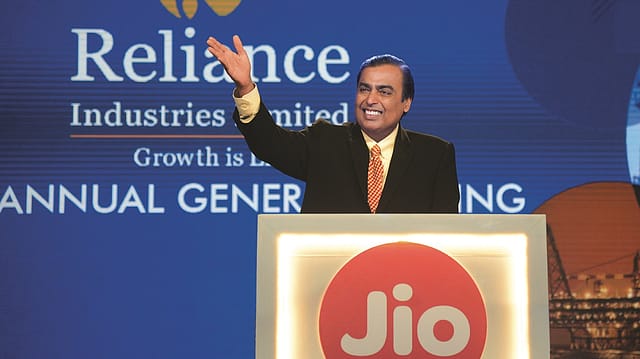Reliance Industries: ₹10 lakh crore and counting
ADVERTISEMENT

Reliance Industries Ltd (RIL), the oil-to-yarn and retail-to-telecom conglomerate led by Asia’s richest billionaire Mukesh Ambani, became the first Indian company to cross a market capitalisation of ₹10 lakh crore on Thursday.
At the close of trading on the BSE on Thursday, RIL’s share price closed 0.6% higher at ₹1,579.95. This translated to a market value of ₹10,01,555 crore. In dollar terms, this translates to a market value of $139 billion. This makes India’s most valuable company larger than gross domestic product (by purchasing power parity) of countries like Kuwait, Ukraine, and Morocco. There are at least 153 countries in the world that have a GDP which is less than RIL’s market cap.
A combination of factors has led to a recent run-up in RIL’s share price. Some of these factors include: consistent earnings growth; continued robust performance by its telecom arm, Reliance Jio Infocomm (Jio), which is also likely to benefit from the weakening competition; a visible path to deleveraging with asset monetisation deals for its telecom infrastructure and refining assets on the anvil; a recent restructuring of the telecom and digital assets business to unlock further value, and a general upswing in the equity markets.
In the past year, the RIL stock has risen a staggering 37.05%, while the benchmark index, S&P BSE Sensex has gained 16%. The Sensex on Thursday closed up 109.5 points or 0.27% at 41,130.17 points.
“A weakened Vodafone Idea allows Jio to accelerate its market share gains. The recently announced debt reshuffling and strategic divestment plan, peaking of capex cycle, and tariff rationalisation could all lead to higher earnings and potentially higher multiples as well,” a research report by Emkay Global dated November 4 said. The brokerage raised its target price on RIL’s scrip to ₹1,680 crore as it anticipates Jio’s Ebitda (earnings before interest, tax, depreciation and amortisation) to rise 3% in FY21 and 20% in FY22.
January 2026
Netflix, which has been in India for a decade, has successfully struck a balance between high-class premium content and pricing that attracts a range of customers. Find out how the U.S. streaming giant evolved in India, plus an exclusive interview with CEO Ted Sarandos. Also read about the Best Investments for 2026, and how rising growth and easing inflation will come in handy for finance minister Nirmala Sitharaman as she prepares Budget 2026.
The Indian telecoms sector has witnessed massive upheaval since the Supreme Court passed a verdict in October on a 14-year-old case upholding the government’s definition of adjusted gross revenue (AGR) for telecom companies (which includes non-core revenue as well). The apex court’s order has meant that these telecom companies, put together, will have to fork out a staggering ₹1.33 lakh crore towards past dues arising from licence fees and spectrum usage charges—calculated as a percentage of AGR—for previous years. Since most of these dues will have to be paid by Vodafone Idea and Bharti Airtel, the only two private sector telcos surviving from that period, their balance sheets are expected to weaken further. This will likely limit their ability to invest in network infrastructure upgrades and future expansion, and benefit Jio—which entered the market in 2016 and captured a large share of the market with cheap data tariffs.
Moreover, to ensure financial viability the telecom industry, which was hitherto engaged in a bruising tariff war, has also unanimously decided to undertake price hikes, beginning December, which will help all telcos, including Jio, improve financials. In sync with its plans to pare debt, RIL struck a deal with Canada’s Brookfield Infrastructure Partners to monetise its telecom tower assets. Brookfield will be paying $3.7 billion to pick up a stake in a trust that will hold these assets.
There are tailwinds also visible in RIL’s other large business of crude refining, which have also lifted investor sentiment in recent times. Analysts estimate RIL’s gross refining margins (GRMs) to also improve in line with a general improvement in the industry. Being a complex refiner, RIL has always enjoyed higher GRMs than the benchmark Singapore GRM. Moreover, RIL announced a deal to offload a 20% stake in its oils-to-chemicals business to Saudi Aramco, which valued this vertical at $75 billion.
RIL also announced a new structure for its telecom and digital services businesses in October that enthused investors. The new super subsidiary that RIL will create will be the principal holding company for its telecom services (Jio) and digital services (a suite of apps and strategic investments) businesses. It may well become the second highest-valued digital platform company in the world after Amazon, when considering the metric of EV/Ebitda (enterprise value by earnings before interest, tax, depreciation and amortisation), according to a Jefferies research report.
Though the proposed restructuring will not alter RIL’s consolidated debt position, it will help deleverage the digital platforms and telecom services business, priming it for a potential stake sale. Debt on the books of the standalone company, which houses the energy and petrochemicals business, will go up commensurately, but repatriation of proceeds from the stake sale in the platform company, along with the aforementioned monetisation deals will help bring this leverage down over time.
Bloomberg also recently reported that RIL was in talks with Sony Pictures Networks to explore a potential stake sale in its vast media and entertainment business. It also reported that the conglomerate was in talks with the Times group for a potential divestment or stake sale in its news media business. RIL, Sony and the Times group has neither confirmed nor denied these talks. To be sure, these reported discussions may not lead to any concrete transaction.
